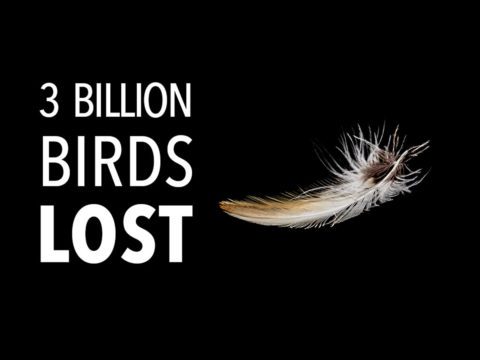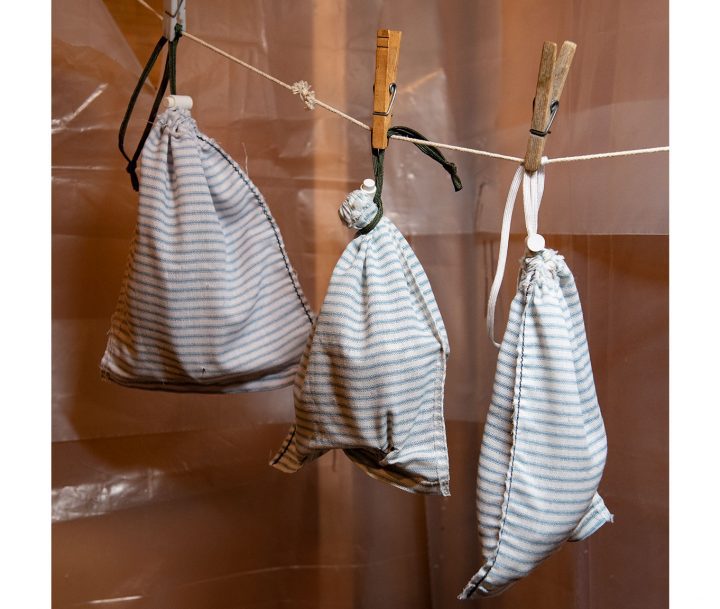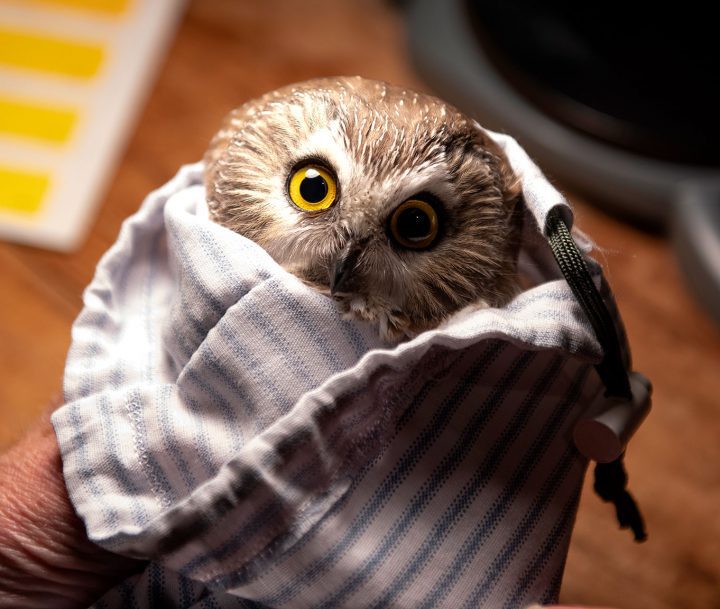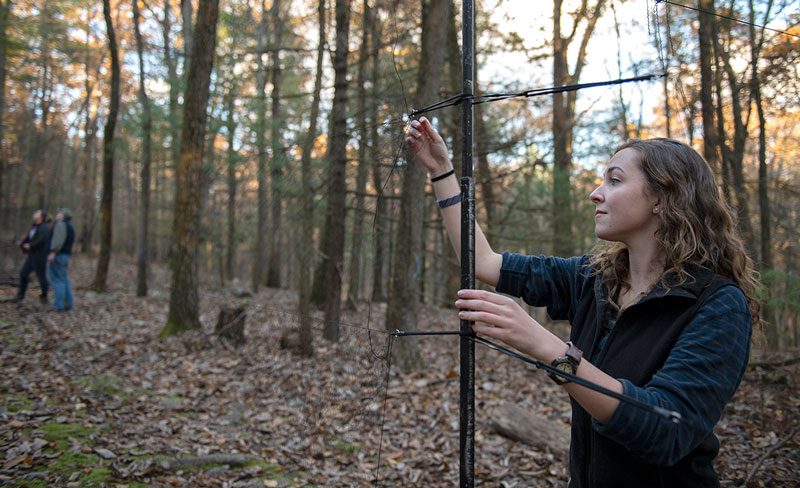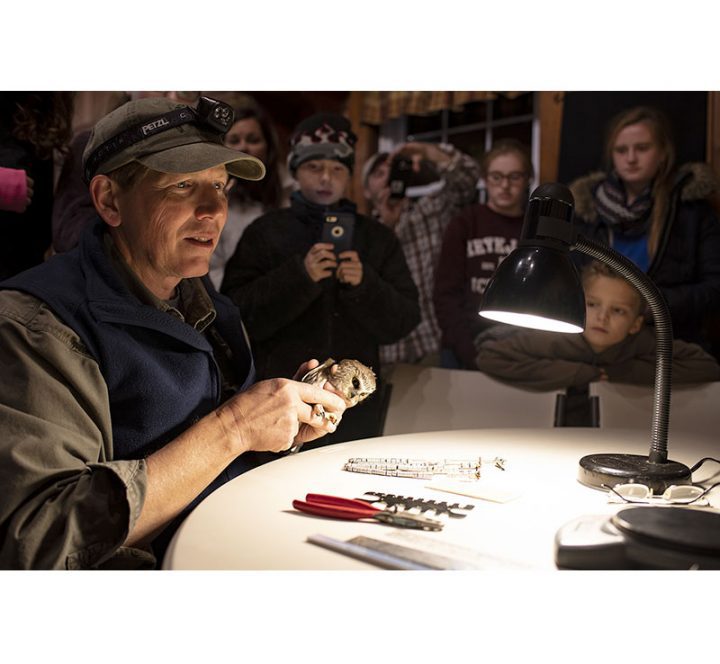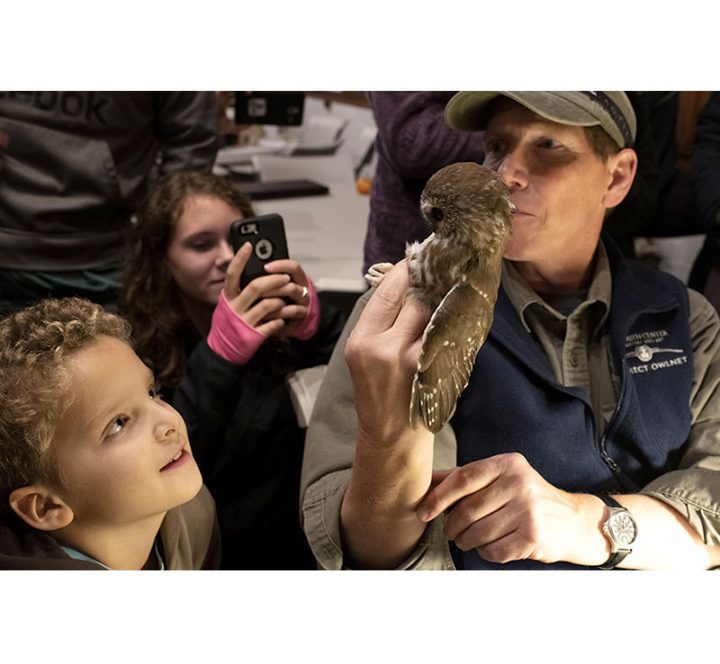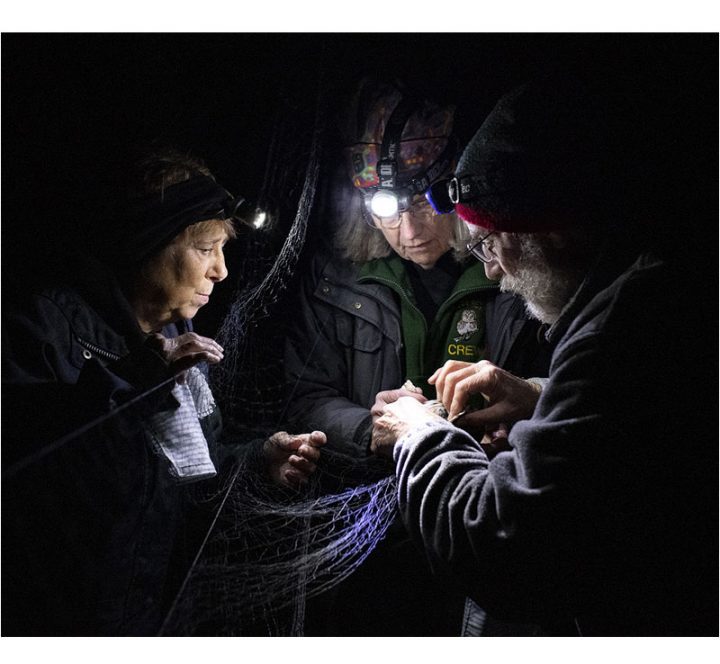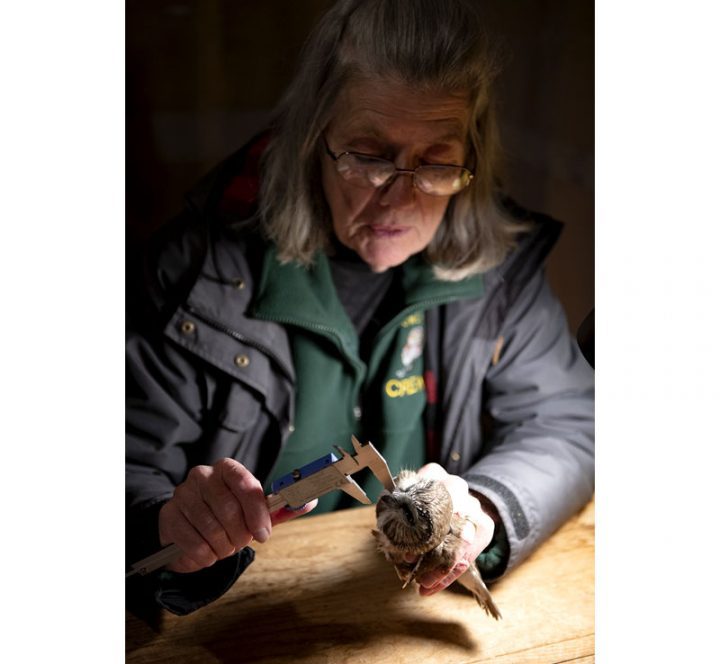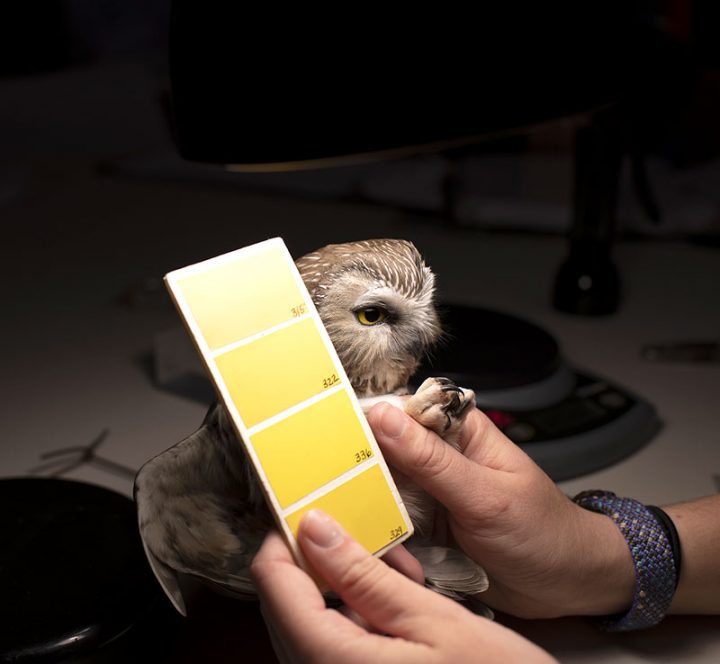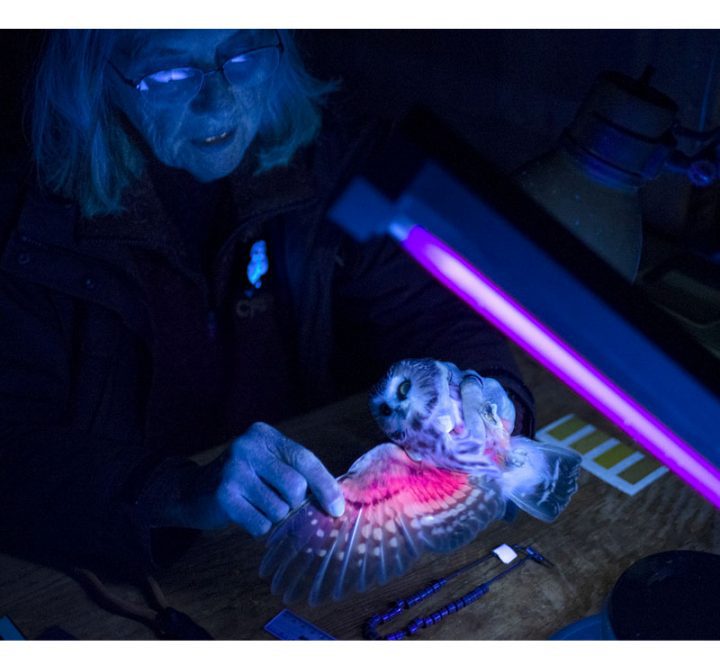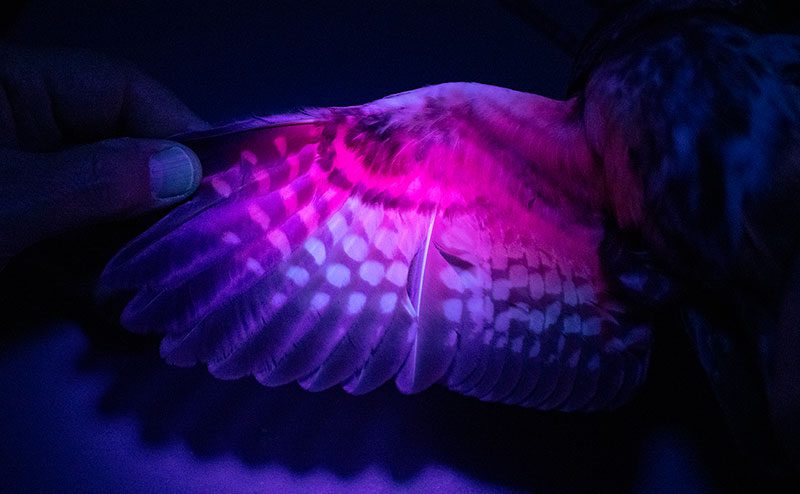A Grassroots Banding Project Reveals How Amazing Northern Saw-whet Owls Are
Story By Scott Weidensaul; Photography By Chris Linder
Northern Saw-whet Owl taken out of a net. Photo by Chris Linder. October 9, 2019From the Autumn 2019 issue of Living Bird magazine. Subscribe now.
There is something wonderful about an autumn night; the sharp bite to the air, the rustle of a north wind in the last leaves clinging to the tops of the oaks, Orion shining in a moonless sky over the central Appalachian ridges of Pennsylvania—and echoing over it all, a repetitive, mechanical beep that reminds most people of the warning alarm when a garbage truck is backing up.
That sound—in this case, an audio recording played through a pair of bullhorn speakers—isn’t automotive. Instead, it’s the toot-toot-toot call of a Northern Saw-whet Owl, the male’s breeding song that’s used by scientists to lure migrating saw-whets out of the star-shot sky and into mist nets. I’ve spent close to a thousand autumn nights like this over the past two decades, in my work as a researcher capturing and studying this mysterious little bundle of feathers. Yet as I climb the lower slope of the ridge that leads to our nets, I’m still as excited as I was back in the 1990s, embarking on our studies of the unseen evening migrations of these most enigmatic raptors in North America.
One thing’s for sure, the hill hasn’t gotten any less steep in the past 23 years. But my companions and I don’t wait to catch our breath; shining our headlamps down along the line of nets, I can see three—no, four—small, gray-brown bodies cradled and wriggling in the mesh, and likely more around the corner where the remaining array forms an L shape. Someone flips a switch to turn off the audio playback, and the night goes silent as I reach carefully into the net and grasp the small, fully feathered feet of the owl to keep its needlelike talons out of my fingers. In a few moments I have slipped the owl free from the mesh.

The tiny owls are wrapped up in cloth bags to keep them calm until it’s time for researchers to conduct a brief examination. Photos by Chris Linder 
A saw-whet is ready for a quick exam when researchers will collect data and affix an identifying leg band.
Only the size of a soda can, a saw-whet is a diminutive raptor, but don’t mistake its wee size for a lack of moxie. This bird has fluffed out its feathers in a bid to intimidate the giant primate holding it, and is rapidly clacking its bill in a dead-serious threat as I slip the little owl into a lightweight cotton bag and cinch the drawstring tight. The owl snaps its beak once again and I glance down to see the tips of eight sharp, shiny black talons poking through the cloth as I move to the next bird.
By the time we head back down the hill to a little cabin, we have nine freshly caught saw-whets in cloth bags. The birds must be weighed, measured, sampled for blood and feather analysis, and outfitted with tiny metal leg bands—the latest additions to a continental monitoring effort that has solved some (but by no means all) of the mysteries surrounding this tiny bird of prey.
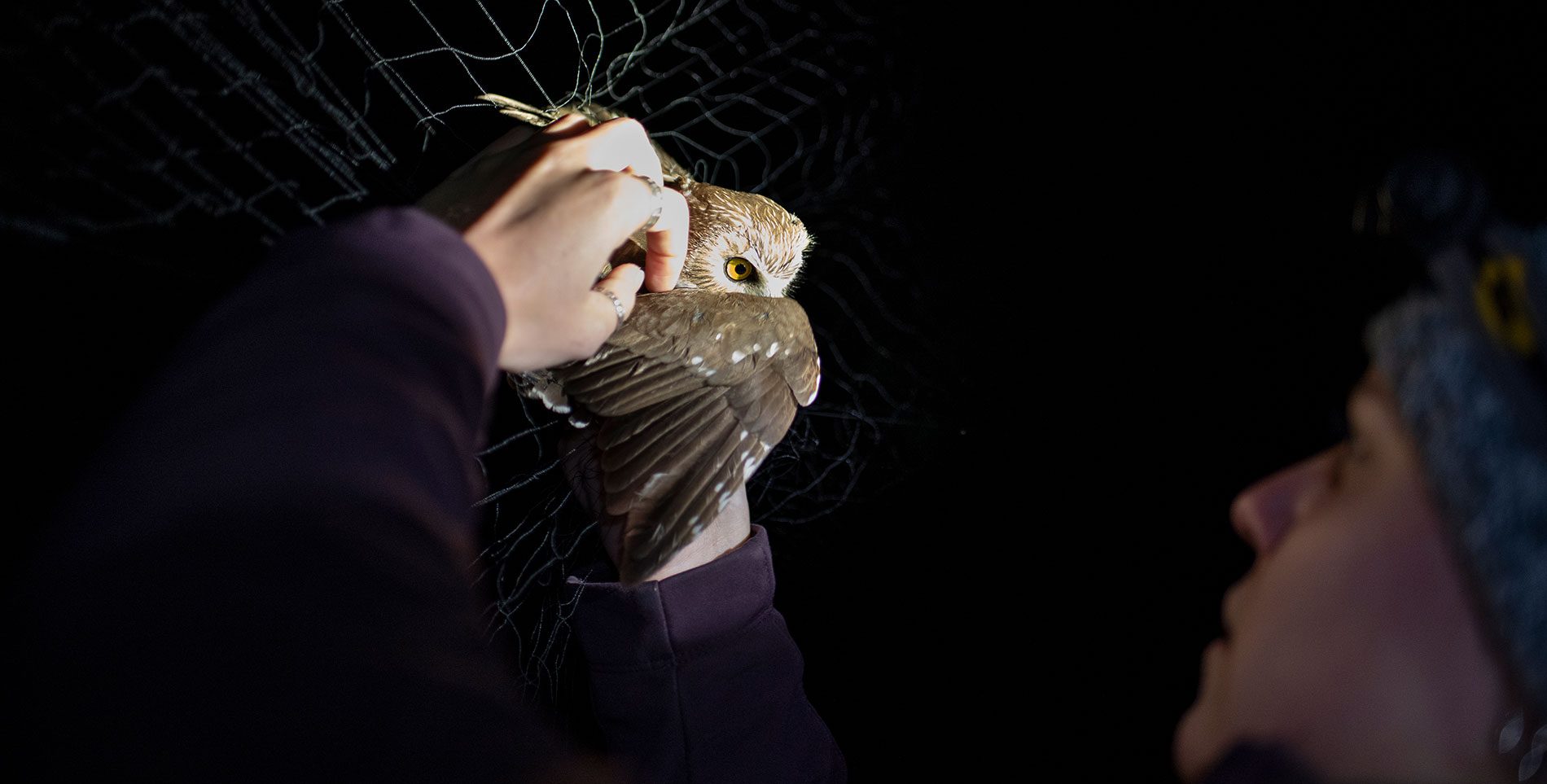
A Mysterious Little Owl Brought to Light
My first encounter with saw-whets in the hand came in 1996. The previous autumn Eric Atkinson—at the time a biologist at Hawk Mountain Sanctuary near my home in eastern Pennsylvania—had banded a stunning 80 saw-whets in his rural backyard with the help of his wife Melonie. They were trying what was then a fairly new approach using an audiolure recording, and their 80 owls in a single season astounded anyone who considered saw-whets incredibly rare—which was almost everyone.
In the mid-1990s, saw-whets were listed as a candidate species for state protection in Pennsylvania, a bird so infrequently seen that even the most avid birders I knew might go a lifetime without spotting one. So I was both shocked and very intrigued by the Atkinsons’ results. At the time, my consuming passion was banding hawks, falcons, and eagles on migration through the Appalachians—raptors that were trapped during the day. But I’d felt the first, seductive tug from the Dark Side with the Atkinsons on those autumn nights at Hawk Mountain, and after catching several saw-whets myself, I was hooked. By the next year, with some seed money from a small state grant, we had recruited a loose network of banding stations across Pennsylvania to target saw-whets.
I oversaw one of those first stations for the Ned Smith Center for Nature and Art, and that effort, now in its 23rd year of netting these little nighttime owls in central Pennsylvania, has become one of the largest saw-whet research programs in North America. With a team of 20 federally licensed banders and a total crew of nearly 100 people—all of us volunteers—working at three research sites, the Ned Smith Center stations have banded more than 12,000 owls and pioneered the use of a number of new technologies, including geolocators and nanotags, to study owl migration. Every rainless night from the beginning of October until after Thanksgiving we’re in the woods, stretching our nets into the midnight hours and playing that repetitive, garbage-truck call.
The bird at the heart of all this effort is still enthralling, but less of a cipher than it was two decades ago (and no longer listed as a candidate species in Pennsylvania, in part because of our work documenting it).
The Northern Saw-whet Owl is the smallest raptor in eastern North America. In our studies, larger females averaged about 96 grams, a little more than half the weight of an Eastern Screech-Owl and a bit less than an American Kestrel. Male saw-whets only averaged about 78 grams, but we don’t see many males.
One of the abiding puzzles about these birds is the dramatically skewed sex ratio at banding stations across their range, where females outnumber males three or four to one. Almost all of the males that are caught are juveniles making their first migration. Out of 12,000 or so saw-whets we’ve banded in Pennsylvania, only about a dozen—literally one in a thousand—have been fully adult males.
Where are the grown-up guys? There’s no doubt that our sample is biased to some degree because our audiolure is a male courtship call, which should be more attractive to females. (Though why female owls are attracted to a breeding call in autumn remains a puzzle.) Recent work by our colleagues Chris Neri and Nova Mackentley at Whitefish Point Bird Observatory in Michigan found that playing a female vocalization at one set of nets increased the male capture rate there; but they also found that females still dominate the sampled saw-whet migration overall.
A female bias in saw-whet migration could be explained by looking to Scandinavia. There, studies of the saw-whet’s closest relative, the Boreal Owl (or Tengmalm’s Owl, as it’s known in Europe), have documented adult males remaining in their northern breeding range through the winter. Perhaps (as with Boreal Owls) male saw-whet owls move widely and somewhat nomadically to find areas with high rodent populations, so they can establish territories and be ready when the females come back north. But so far this behavior remains a hypothesis awaiting confirmation.
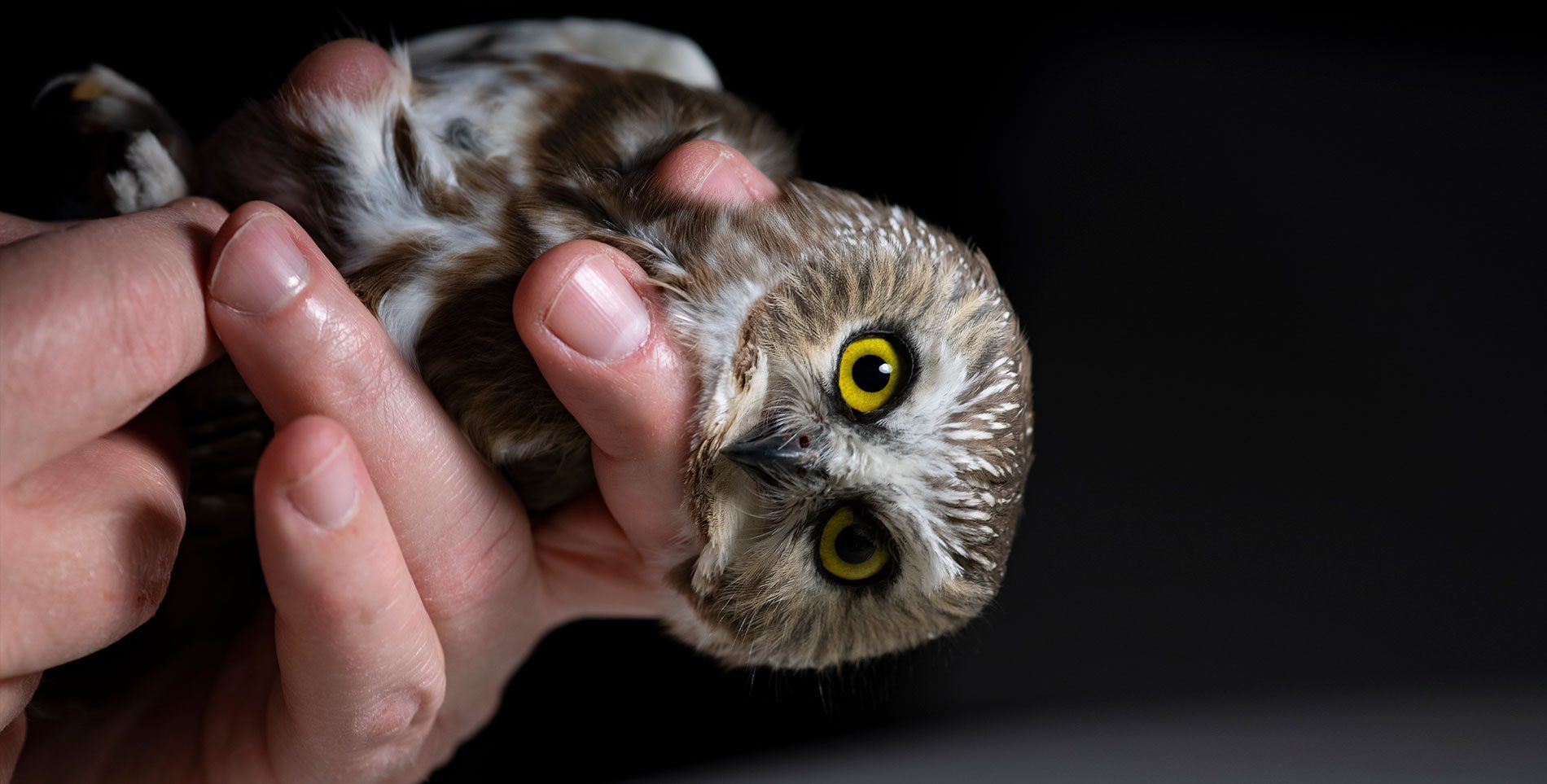
Nomadic Sojourners

The author enthralls a school group by introducing them to a Northern Saw-whet Owl. All photos by Chris Linder. 
Over the years, children inspired by saw-whets at the Ned Smith Center research stations have grown up to become scientists leading research in climate studies and ornithology. 
Researchers and volunteers are trained to quickly and delicately extract saw-whets from mist nets. 
The beak length is measured during the exam. 
Part of the physical exam includes noting the yellowness of the eyes by comparison with a housepaint color palette from a hardware store. 
UV black lights reveal the presence of fluorescent pigments that help determine the owl’s age. See sidebar below for more.
Saw-whets are oddball birds, hard to pigeonhole in a number of respects. Their migrations are highly cyclical, with hordes coming south every three to five years, but far fewer at other times. Many birders, and more than a few ornithologists, refer to saw-whets as irruptive, but they don’t fit the classic definition; their migrations are regular, and while the number of adults we catch each fall fluctuates a bit from year to year, it’s fairly stable over time.
A big flight year is almost entirely the result of a massive influx of juveniles into the population. The youngsters, in turn, are the product of population spikes in small rodents in the northern U.S. and Canada (especially red-backed voles, a favorite prey of this raptor), which follow autumns when the spruce and fir trees in the boreal forest groan under heavy cone crops.
We can make a pretty good guess about the magnitude of next year’s owl flight by looking at the size of this autumn’s boreal cone crop. Lots of cones means lots of seeds (rodent food), and if there are lots of rodents, saw-whets respond by laying large clutches of eggs, up to nine in a nest. Some females manage to produce two clutches of eggs in two nests, with two different males, in a single season. Those are the boom years—like 1995, 1999, 2007, and 2012 in the Northeast—when we’ll catch nearly a thousand owls at our three saw-whet banding sites in central Pennsylvania, three-quarters of them juveniles. In a normal year, we’ll catch only a couple hundred mostly adult saw-whets.
Whereas most migratory bird species show strong loyalty to their breeding and wintering locations (I’m reminded of the banded Cerulean Warbler that overwintered in the same corner of the same shade-coffee farm in Colombia five years in a row), that’s not the case with saw-whets. One owl we tagged with a geolocator wintered some years as far south as western Virginia, and other years close to the Canada–New York border. Some years this female migrated into Quebec to breed, but in others she remained in the mid-Atlantic states. Although a broader analysis of saw-whet banding recoveries across their migratory range showed that these owls tend to stick to regional flyways, our research has confirmed how nomadic some of these tiny sojourners can be within those bounds.
While the science has obviously been interesting, the human element of our project has had its own rewards. It’s been a great example of highly successful citizen science. Perhaps not surprisingly, our team of banders includes some professional wildlife biologists whose day jobs are with state agencies or environmental nonprofits—but it also includes a union plumber, a machinist, active and retired high school teachers, a law professor, an environmental educator, and an information systems manager. We’ve hosted college interns from Penn State University, and on occasion we’ve brought kids as young as 11 (and their parents) onto the team, with terrific results. Several of our youngest saw-whet team members have gone on to great careers; one is conducting postdoctoral research in climate science, and others have become noted birding guides and field ornithologists.
I often refer to saw-whets as a gateway drug for conservation, because they are, after all, the perfect combination of a ferocious predator in a small, nonthreatening package—cute and cuddly to the human eye, but with all the gravitas of the largest carnivore. Over the years we’ve hosted thousands of people at our banding stations, from Cub Scout packs to university classes, and I have yet to encounter a single person, no matter how disconnected they may be from the natural world, who doesn’t feel an electric jolt the first time they meet the level stare of those yellow eyes. For many such visitors, that experience is life-changing.
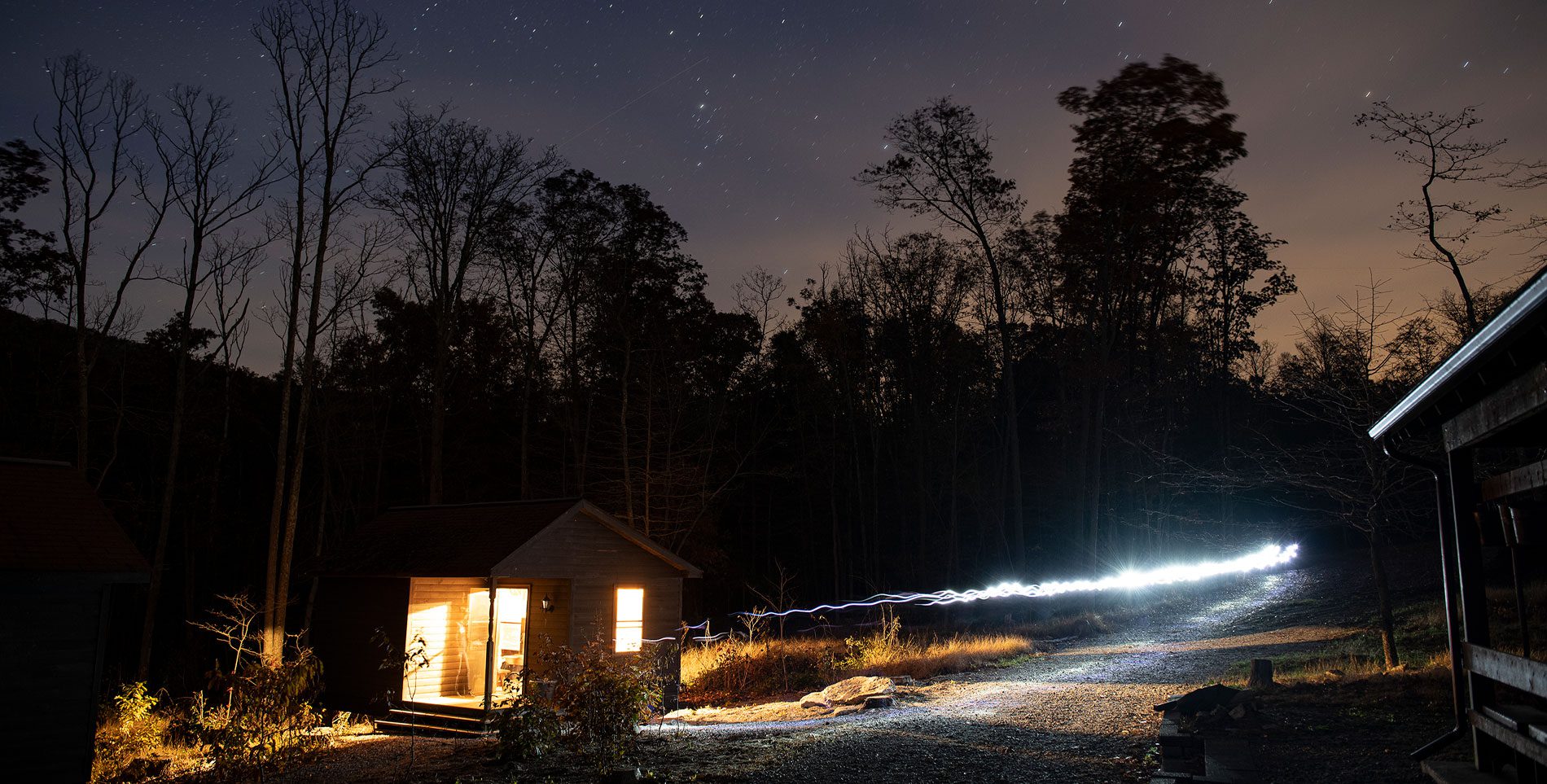
A Grassroots Banding Effort that Spans North America
Our banding stations are not alone in this effort to understand saw-whet migration. We are part of a continental effort known as Project Owlnet, with more than 125 partner stations across Canada, the U.S., and Mexico, all using similar protocols and sharing data and results. Because of this dense network of owl-banding stations, especially in the Northeast and Great Lakes, we routinely net saw-whets in Pennsylvania that have already been outfitted with leg bands—birds that were originally banded as far afield as central Wisconsin, the Bruce Peninsula on Lake Superior in Ontario, or the shores of the St. Lawrence River in Quebec. In all, we’ve captured nearly 500 owls previously banded at other stations. We’ve also had more than 250 of our Pennsylvania-banded birds recaptured at other locations—including one female saw-whet found in a nest box in western Quebec, paired up with a male saw-whet that had been banded at a Project Owlnet site in Michigan. Both birds had flown 600 miles, from opposite directions, to Quebec to find each other.
How far south saw-whets migrate is an open question. They are so secretive that, absent targeted mist-netting research of the sort we undertake, it’s easy to miss them completely. Over 43 years dating back to 1961, Alabama had only seven accepted records of Northern Saw-whet Owls. But after I convinced a couple of friends near Birmingham to set up an audiolure station at their home in 2007, they began catching saw-whets regularly. Alabama now has hundreds of saw-whet records from a number of banding stations. Researchers have similarly discovered migrating saw-whets in other regions where the species had previously been considered rare or absent, such as Arkansas. In the West, where saw-whets breed in mountainous terrain all the way into central Mexico, the migration pattern has been much harder to assess, but folks are trying.
Tiny Brown Treasures With Brilliant Yellow Eyes
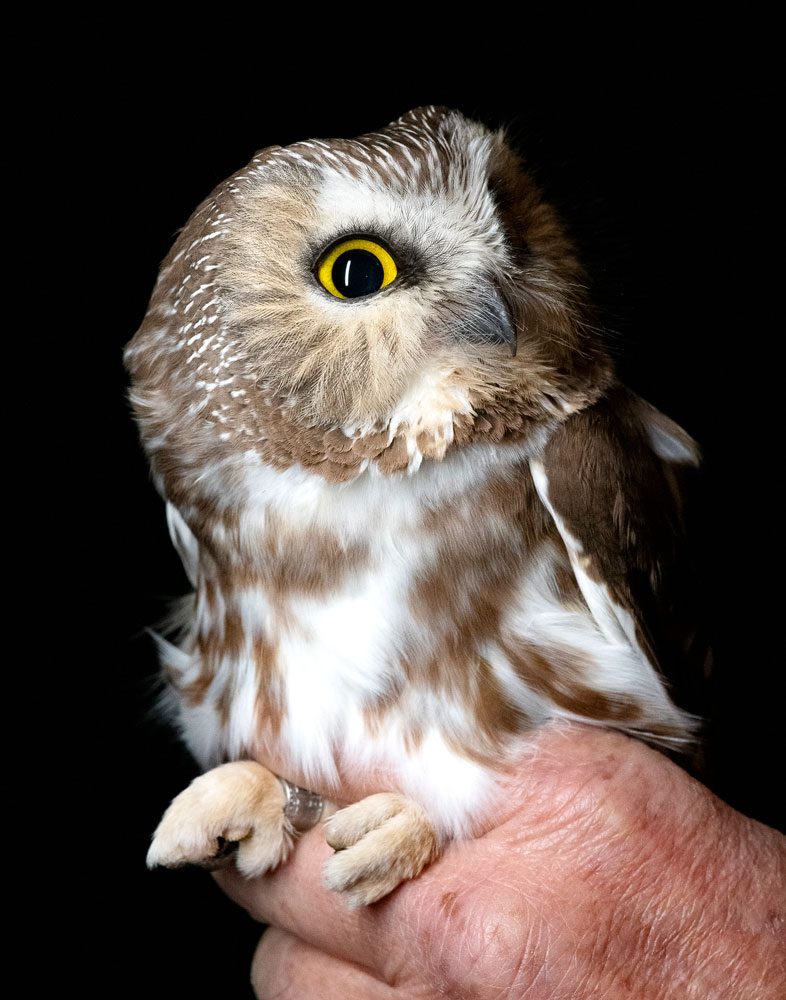
I check my watch. It’s time for another net check, and with the previous batch of owls banded and returned to the woods, my crew and I hike back up the hill through the night, the sound of the audiolure getting louder in our ears with every step. The details vary from site to site, but each year for 23 years we’ve run the same number of nets in the same locations for the same number of nights for that two-month period in October and November, in what’s known as constant-effort mist-netting. Each year’s data, added to those of the past, allow us to ask questions about issues like population trends that we couldn’t before. And every season’s new data make what we’ve collected in previous years increasingly valuable.
Right now we’re tackling the formidable job of analyzing three decades’ worth of capture data from Project Owlnet banding sites across the eastern U.S. and Canada to see what the numbers can tell us about how the overall saw-whet population is faring in the early 21st century. Northern Saw-whet Owls are far more common and widespread than anyone suspected a few decades ago, but there is cause for concern. Banding at Assateague Island in Maryland since 1991 has shown that each successive peak in the saw-whet’s ebb-and-flow cycle has been lower than the previous peaks. This could be just a local issue, but much of the saw-whet’s breeding range lies within the southern boreal forest, where industrial logging is the dominant force on the landscape. Some research suggests these small owls have a harder time successfully feeding their chicks in fragmented forests, and our long-term migration data may show us whether they are maintaining their numbers in the face of such pressure. We’re also looking at whether the warming climate is altering the timing of their migration.
We reach the top of the hill; I’m a little winded, but who cares? The first net has an owl, and I feel the electric charge I always feel when I see those glaring yellow eyes. Glancing down the lane, I see the night has more small, gray-brown treasures to share, waiting for us in the net—feathered answers to questions we’re still just learning how to ask.
Scott Weidensaul has written more than 30 books and is a codirector of Project Owlnet. He has been studying bird migration of all sorts since the 1980s. His newest book, about migration science and global migratory bird conservation, will be published in 2020 by W. W. Norton.

All About Birds
is a free resource
Available for everyone,
funded by donors like you
American Kestrel by Blair Dudeck / Macaulay Library
